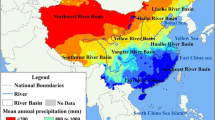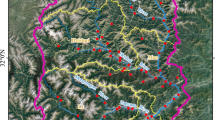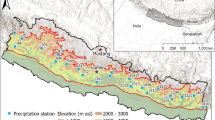Abstract
In the context of climate warming and urbanization, predictions and inundation simulations for future extreme precipitation have become highly active research topics. In this paper, using daily precipitation recorded at 10 meteorological stations in Shanghai for the period 1961–2010, the daily precipitation of each station during the period 2011–2099 was simulated by the statistical downscaling model (SDSM). And we examined the varying tendencies of future precipitation by the Mann- Kendall test. Further, the Soil Conservation Service (SCS) model and Pearson-III distribution curve were used to simulate the waterlogging duration and depth of future extreme precipitation in different scenarios with 3-, 5-, 10-, 20-, 50-, and 100-year return periods. The results show that: 1) Precipitation in Shanghai before the 2050s shows a trend of increasing and decreasing alternations, followed by a trend of decreasing and a marked decrease in about the 2070s. 2) In the 21st century, the waterlogging duration with return periods of 3, 5, and 10 years in Shanghai is predicted to last for less than 30 minutes, while the return periods of 20, 50, and 100 years last for less than 45 minutes. From the spatial distribution, the waterlogging duration to the east and south of the Huangpu River is predicted to be shorter than that of the west and north. 3) With the increase of the return periods, the depth of waterlogging is predicted to increase. The deepest inundated areas are Jinshan to the south-west of Shanghai, the east side of the Huangpu River, and Chongming Island.
Similar content being viewed by others
References
Brown C, Wilby R L (2012). An alternate approach to assessing climate risks. Eos (Wash DC), 93(41): 401–402
Chen Y D, Zhang Q, Xiao M Z, Singh V P, Leung Y, Jiang L G (2014). Precipitation extremes in the Yangtze River Basin, China: regional frequency and spatial–temporal patterns. Theor Appl Climatol, 116 (3–4): 447–461
Chi X X, Yin Z E, Wang X, Sun Y K (2016). Spatiotemporal variations of precipitation extremes of China during the past 50 years (1960–2009). Theor Appl Climatol, 124(3–4): 555–564
Fan L J, Fu C B, Chen D L (2005). Review on creating future climate change scenarios by statistical downscaling techniques. Advances in Earth Science, 20(3): 320–329 (in Chinese)
Fu C B, Wang Q (1992). The definition and detection of the abrupt climatic change. Chin J Atmos Sci, 16(4): 482–493
Gao T, Xie L (2016). Spatiotemporal changes in precipitation extremes over Yangtze River Basin, China, considering the rainfall shift in the late 1970s. Global Planet Change, 147: 106–124
Guan Y H, Zheng F L, Zhang X C, Wang B (2017). Trends and variability of daily precipitation and extremes during 1960–2012 in the Yangtze River Basin, China. Int J Climatol, 37(3): 1282–1298
Hang R H, Chen J L, Zhou L T, Zhang Q Y (2003). Studies on the relationship between the severe climatic disasters in China and the East Asia climate system. Chin J Atmos Sci, 27(4): 770–787
He F F, Gu X D, Xu J L (2006). Studies on radiation resource change in Shanghai since the 1990s. Journal of Natural Resources, 20(2): 210–216 (in Chinese)
Hu Z, Yang S, Wu R (2003). Long-term climate variations in China and global warming signals. J Geophys Res D Atmospheres, 108(D19): 4614
IPCC (2013). Climate Change 2013: The Physical Science Basis. Cambridge University Press
Li Q P, Ding Y H (2005). Multi-year simulation of the East Asian monsoon and precipitation in China using a regional climate model and evaluation. Acta Meteorol Sin, 19(3): 302–316
Liao Y F, Nie C J, Yang L S, Li H R (2012). An overview of the risk assessment of flood disaster. Progress in Geography, 31(3): 361–367 (in Chinese)
Liu B J, Chen J F, Chen X H, Lian Y Q, Wu L L (2013). Uncertainty in determining extreme precipitation thresholds. J Hydrol (Amst), 503 (11): 233–245
Lu H, He H, Chen S R (2010). Spatiotemporal variation of extreme precipitation frequency in summer over South China in 1961–2008. Journal of Ecology, 29(6): 1213–1220 (in Chinese)
McCuen R H (1982). A Guide to Hydrologic Analysis Using SCS Method. Englewood Cliffs: Prentice-Hall
Novotny V, Chesters G, Shannon J (1981). Handbook of Non-Point Pollution Source and Management. New York: Van Nostrand Reinhold Company
Qian W H, Fu J L, Zhang W W, Lin X (2007). Changes in mean climate and extreme climate in China during the last 40 years. Advances in Earth Science, 22(7): 673–683 (in Chinese)
Quan R S, Liu M, Hou L J, Lu M, Zhang L J, Ou D N, Xu S Y, Yu L Z (2009). Impact of land use dynamic change on surface runoff: a case study on Shanghai Pudong new district. Journal of Catastrophology, 24(1): 44–49 (in Chinese)
Schreider S Y, Smith D I, Jakeman A J (2000). Climate change impacts on urban flooding. Clim Change, 47(1–2): 91–115
Shanghai Municipal Drainage Administration (2007). Shanghai urban rainwater system professional planning. http://www.smda.org.cn/ fore/Detail.aspx?id = 4802/ (accessed 16 August 2017)
Shanghai Municipal Statistics Bureau (2015). Shanghai Statistical Yearbook 2015. Beijing: China Statistics Press (in Chinese)
SL44 (1993). Design flood code for water conservancy and hydropower projects. https://wenku.baidu.com/view/e1895cd4b14e852458fb 575e.html/ (accessed 26 June 2017)
Sukovich E M, Ralph F M, Barthold F E, Reynolds D W, Novak D R (2014). Extreme quantitative precipitation forecast performance at the weather prediction center from 2001 to 2011. Weather Forecast, 29(4): 894–911
Tao H, Bai Y G, Mao W Y (2012). Assessment of CMIP3 climate models and projected climate changes in northern Xinjiang. Geogr Res, 31(4): 589–596
Tao S Y, Wei J (2007). Correlation between monsoon surge and heavy rainfall causing flash-flood in southern China in summer. Meteorol Monogr, 33(3): 10–18
Wilby R L, Dawson C W (2013). The statistical down scaling model (SDSM): insights from one decade of application. Int J Climatol, 33 (7): 1707–1719
Xu L J, Li J Q, Li T, Liu X H (2007). On rainstorm intensity formula during little time in Shanghai. China Municipal Engineering, 4: 46–48
Xu S Y, Su J, Wang Z, Liu M, Zhang Z L, Wu J P, Huang YM, Shi C, Lu L H (2004). Atlas of Shanghai urban physical geography. Shanghai: Chinese Map Publishing House (in Chinese)
Yin J, Yu D P, Wilby R (2016). Modelling the impact of land subsidence on urban pluvial flooding: a case study of downtown Shanghai, China. Sci Total Environ, 544: 744–753
Yuan Z, Yang Z Y, Yan D H, Yin J (2017). Historical changes and future projection of extreme precipitation in China. Theor Appl Climatol, 127(1–2): 393–407
Zheng T F, Guo J M, Yin J F, Wang Q, Wu W (2012). DFA-based research on spatiotemporal distribution of extreme precipitations in Jiangsu Province. Journal of Natural Disaster, 21(4): 76–83 (in Chinese)
Zhou L Y, Yang K (2001). Variation of precipitation in Shanghai during the last one hundred years and precipitation differences between city and suburb. Acta Geogr Sin, 56(4): 467–476
Zhu Y Y, Wang Y (2006). Frequency distribution statistical test of urban short-duration rainstorm in Fujian Province. Journal of Fuzhou University (Natural Science Edition), 34(3): 415–419 (in Chinese)
Acknowledgements
The work was supported by the National Natural Science Foundation of China (Grant Nos. 41371493 and 41071324), and the Innovation Program of the Shanghai Municipal Education Commission (13YZ061).
Author information
Authors and Affiliations
Corresponding author
Rights and permissions
About this article
Cite this article
Wang, X., Yin, Z., Wang, X. et al. A study on flooding scenario simulation of future extreme precipitation in Shanghai. Front. Earth Sci. 12, 834–845 (2018). https://doi.org/10.1007/s11707-018-0730-z
Received:
Accepted:
Published:
Issue Date:
DOI: https://doi.org/10.1007/s11707-018-0730-z




